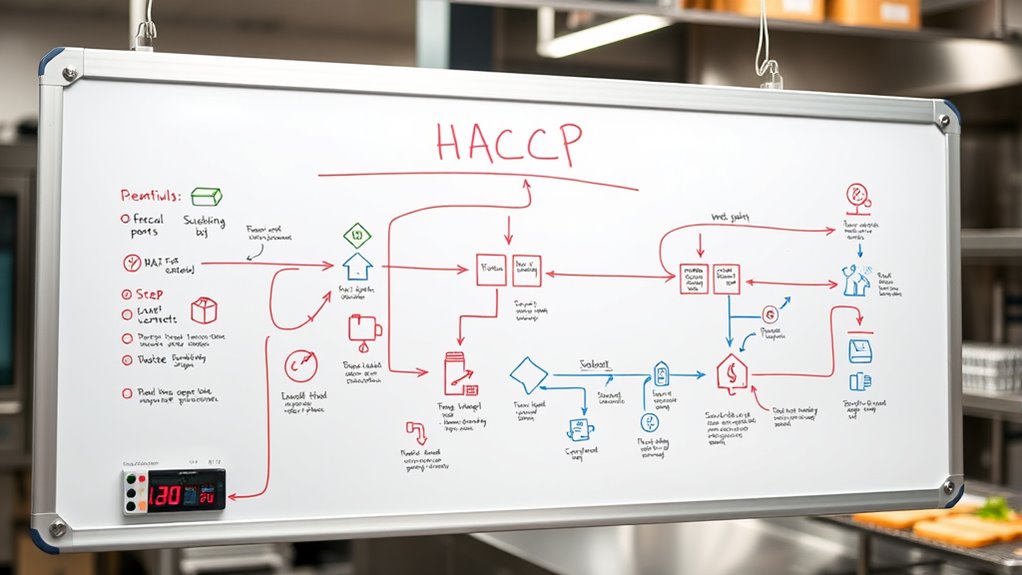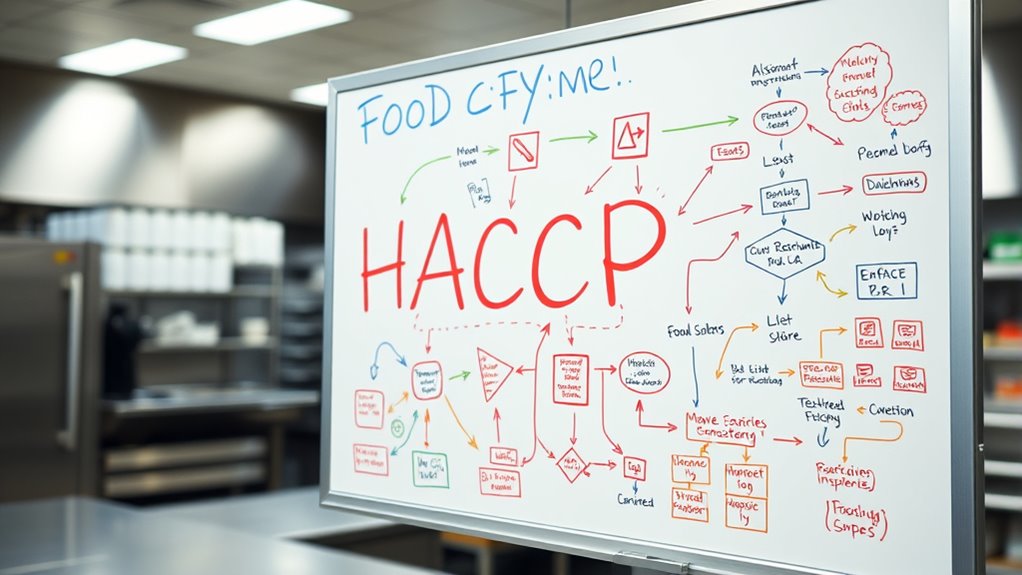A HACCP flow diagram is a detailed visual map of your food production process that highlights each step from raw materials to packaging. It helps you identify potential hazards, control points, and vulnerabilities like cross-contact or temperature issues. By mapping out everything clearly, you can improve safety measures and guarantee regulatory compliance. Keep exploring to discover how this tool can enhance your food safety management and protect consumers.
Key Takeaways
- A HACCP flow diagram visually maps each step in the food production process to identify potential hazards.
- It includes detailed process stages from raw material receipt to packaging for thorough analysis.
- The diagram helps pinpoint risks like cross-contact, temperature abuse, and equipment hazards.
- It serves as a reference tool to implement and monitor food safety controls effectively.
- Using a HACCP flow diagram promotes regulatory compliance and enhances overall food safety management.

A HACCP flow diagram is a visual tool that outlines each step in your food production process to identify potential hazards and guarantee food safety. This process mapping helps you visualize where risks might occur, allowing you to implement controls effectively. When you create a flow diagram, you’re fundamentally charting out every stage, from receiving raw materials to final packaging, which makes it easier to spot vulnerabilities that could compromise food safety. Incorporating calibration practices can further enhance the accuracy of your hazard detection and control measures.
By mapping out your process visually, you can see how each activity connects and where key points exist. This clarity is essential because it helps you understand the flow of ingredients, personnel movements, equipment use, and storage steps. With process mapping, you get a detailed overview that makes it easier to analyze and improve your food safety protocols. You’ll be able to identify points where contamination could occur, such as cross-contact, temperature abuse, or improper handling, and then put measures in place to mitigate those risks.
A well-designed HACCP flow diagram isn’t just a reference; it’s a proactive tool. It guides your team through the entire production cycle, ensuring everyone understands each step and the importance of maintaining safety standards. When creating your diagram, be thorough and precise—include every process detail, from washing raw ingredients to final inspection. This detailed process mapping helps you pinpoint where hazards might originate and evaluate whether current controls are sufficient or need enhancement.
In addition to identifying hazards, the process map serves as a communication tool that aligns your team’s understanding of food safety priorities. It makes training easier because new employees can quickly grasp the entire flow and understand the significance of each step. Plus, it supports your compliance efforts, as regulatory agencies often require detailed process documentation to verify your food safety practices.
Using a HACCP flow diagram also simplifies the process of conducting hazard analysis. When you see your process mapped out visually, it becomes easier to evaluate risks systematically and determine critical control points. You can then establish critical limits, monitoring procedures, and corrective actions more confidently. Process mapping with a flow diagram makes your food safety management more organized, reducing the chance of oversight or mistakes.
Frequently Asked Questions
How Often Should a HACCP Flow Diagram Be Updated?
You should update your HACCP flow diagram whenever there’s a change in your process, equipment, or ingredients to guarantee ongoing regulatory compliance. Regular reviews, at least annually, help maintain accurate process mapping and identify potential hazards. Keeping the diagram current allows you to adapt swiftly to operational changes, supporting food safety and compliance. This proactive approach ensures your HACCP plan remains effective and aligned with industry standards.
Can Small Businesses Implement a HACCP Flow Diagram Effectively?
Yes, small businesses can implement a HACCP flow diagram effectively, but they might face implementation challenges like limited resources or expertise. To succeed, you should start with simple, clear diagrams tailored to your operations, involve your team, and seek guidance from food safety professionals if needed. Overcoming these challenges helps guarantee your food safety processes are thorough, compliant, and sustainable, ultimately protecting your customers and your business reputation.
What Software Tools Are Recommended for Creating Flow Diagrams?
When it comes to creating flow diagrams, you’ll want to explore digital tools and diagram software like Microsoft Visio, Lucidchart, or Canva. These digital tools make crafting clear, professional diagrams a breeze and help you visualize processes effectively. Don’t reinvent the wheel—use these diagram software options to streamline your workflow and guarantee your HACCP plan stays on track. It’s a smart move to keep everything running smoothly.
How Does a Flow Diagram Assist in Hazard Analysis?
A flow diagram helps you with hazard analysis by enabling clear process mapping, which makes risk identification easier. As you chart each step, you can spot potential hazards at specific points, allowing you to evaluate where controls are necessary. This visual approach helps you understand the entire process better, guaranteeing you don’t overlook risks and can implement effective measures to ensure food safety throughout the production.
Are There Industry-Specific Differences in HACCP Flow Diagrams?
You might wonder if industry variation affects HACCP flow diagrams. In fact, they do differ because each industry requires specific hazard controls, so diagrams often need customization. For example, processing plants, catering services, or dairy farms adapt their flow diagrams to address unique risks and steps. This customization guarantees the diagram accurately reflects operational realities, helping you identify hazards more effectively and maintain safety standards tailored to your industry’s needs.
Conclusion
Now that you know what a HACCP flow diagram is, you’re basically a food safety superhero! With this diagram, you can spot hazards faster than a speeding bullet and save your kitchen from disaster. It’s like having a secret weapon against foodborne illnesses in your back pocket. So, go ahead, embrace it — because, honestly, a well-mapped flow diagram might just be the most powerful tool in your culinary arsenal!









